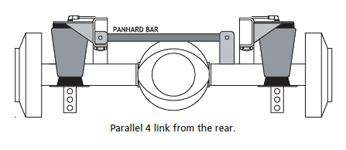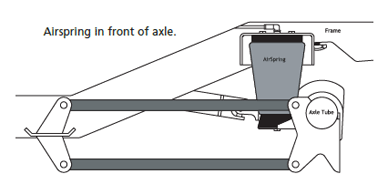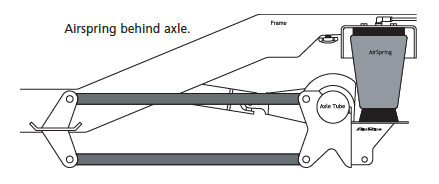4 Link Comparison – Triangulated vs Parallel

Let’s compare two popular types of 4-link rear suspension systems. A 4-Links is a great way to upgrade your car’s performance and ride quality — especially when compared to leaf springs. Although there are several theories as to which type of 4-link is “better”, it comes down to available space and preference. Triangulated 4-links and parallel 4-links accomplish the same thing. They locate the rear axle in the vehicle in its proper place. The bottom 2 links keep the axle in place front to back. The upper 2 links keep the axle from rotating, keeping the pinion angle as constant as possible. Beyond that one basic function, the two designs begin to differ.

On a triangulated 4-link the uppers bars are placed at an angle relative to the vehicle centerline. When connected securely to the axle and the frame, they form a “triangle”. This is what keeps the rear axle centered under the vehicle. There is no need for a separate lateral locating device.
Conversely, with a parallel style 4-link, all bars are parallel to each other and the vehicle centerline. A “Panhard bar” or other separate device is required to keep the axle centered. The Panhard bar runs perpendicular to the frame rails and horizontally across the vehicle. It connects the axle to the frame by way of links thereby allowing only up and down movement.
A parallel 4-link fits most trucks better because the fuel tank is usually right in front of the axle, inboard of the frame. Universal parallel 4-links are therefore sometimes easier to install because the main link bars utilize a one-piece frame mount instead of two… less time in placing and welding the upper bar mounts. But a parallel 4 link requires a Panhard bar which adds slightly to the expense and can use up valuable space needed for your car or truck’s exhaust system. A Panhard bar will also induce a small amount of side to side movement during suspension travel… not enough to feel but it may
concern the customer who has an extremely tight tire to fender clearance. With a parallel 4 link you are locked into a side frame link position… with a triangulated 4 link the lower links can be placed beside the frame or under the frame for clearance purposes.


Either system is very straight forward to install. You will spend more time with the tape measure than the saw or welder. All else being equal, for the absolute rookie, the parallel may be a bit easier to visualize and understand during installation.
TRIANGULATED 4-LINK
Pros
- NO side to side movement at all… you can run tighter tire to fender clearance.
- Less hardware to buy and install (no Panhard bar)
- Allows flexibility in bar placement to avoid obstacles
Cons
- Angled upper bars can interfere with exhaust
- Angled upper bars can interfere with the fuel tank on late-model trucks
- 4 more attachment points to plot and install (parallel has bar mounts built together)
PARALLEL 4-LINK
Pros
- Slightly easier to visualize and install (bar mounts are built together)
- Can be installed beside frame-rail, inboard or outboard
- May allow more room for exhaust (no angled upper bars)
Cons
- Requires a Panhard bar (extra cost and installation)
- Panhard bar will induce a slight amount of side to side movement during suspension travel… requires slightly more tire to fender clearance.
- Panhard bar may interfere with exhaust
Why should I put a 4-link under my car?
What will a 4-link do better than a leaf spring?
In a leaf spring suspension, the leafs themselves must perform 2 functions. First, they hold the rear axle in the car. They prevent both forward and aft movement and minimize pinion angle change during suspension travel. Secondly, while they are doing this, they also support the load of the vehicle. This is a compromise when compared to link type suspension where the two functions are isolated.
Also, an OEM vehicle that has had thousands of hours of development time behind it will operate within a predictable range of suspension travel, leaf springs do a very adequate job. When the operating envelope is changed… lower ride height, more horsepower, different weight distribution, maybe a trailer, the leaf springs cannot be expected to perform as intended if the operating parameters are changed. To clarify, picture a de-arched leaf that cannot compress.

With 4-link suspension, the two functions of locating the rear axle and supporting the vehicle, are isolated. Springs take care of supporting the vehicle — which leaves the links free to deal with locating and articulation. 4-link rear suspension will properly locate the rear axle no matter how soft we want to make the spring. With a leaf spring rear suspension, softening the spring rate can cause other problems such as side to side flex or axle wrap (when the axle tries to twist the leafs out of the vehicle).
just a few FAQs…
I have a straight axle under my ‘32 with a 4-link and am happy with the ride height and quality. Can I use an air suspension on the rear only?
ABSOLUTELY! We have several customers who have installed a 4 link and air springs or ShockWaves® under the rear of their vehicles to improve ride quality. The rear of the vehicle is where you will actually see the most ride quality improvement. This is because you sit closer to the rear end and any load changes (fuel, passengers, luggage, trailer) will be supported by the rear suspension. For those customers who are looking for ride quality… start with the rear end.

In setting up my rear 4-link air suspension, should I place the air springs in front or behind the axle? Inboard or outboard of the frame rail?
It really comes down to where there is the most room. A forward position will offer slightly more travel and can sometimes offer better ride quality. A rear position can offer slightly more load capacity. Any spring, coil, leaf, or air, will perform better if placed farther apart under the chassis. Keep in mind these performance differences are quite small and that the real criteria should be available space in your particular vehicle.

At what angle should I place the 4 link bars? The Panhard bar? How critical are the angles?
We typically try to place the lower bars level at ride height. this will minimize “roll steer” (slight wheelbase change caused by the arc of the bars going through their travel). The upper bars should also be level, or slightly down at the front if need be. This configuration will provide stable handling and braking characteristics. It is important to get the bars exactly the same from side to side to avoid unpredictable handling problems. It is also extremely important to make sure the Panhard bar is level at your highway ride height. This will minimize side travel of the rear axle induced by the arc of the Panhard bar going through its travel. Obviously there are precise formulas for placement of the 4 link bars to maximize certain performance criteria, but these performance differences are quite small on a road car. Put the bars in level, or close to it, at ride height, and you’ll be fine.
What about “reverse” 4 links? What happens when you run the bars backward?
NO NO NO!!! By the way, did we say NO?! It doesn’t matter what the truck magazines say… DO NOT run the 4 link bars backward! Here’s what happens… When the top bars are run backward, the diverging arcs of the upper and lower bars will create such a massive pinion angle change that under extreme amounts of suspension travel, you may actually pull the driveshaft out of the transmission! If you want to see this effect for yourself, get a sheet of pegboard and a couple of yardsticks… simulate the scenario for yourself. The second effect of running the upper bars backward is completely screwed up handling dynamics. With a normal 4 link, when you hit the brakes, the suspension geometry wants to lift the rear of the vehicle…. therefore trying to “plant” the rear tires and assisting the braking action. When the upper bars are reversed, this dynamic is eliminated or even reversed… when you hit the brakes the suspension actually unloads the tires thereby massively reducing available braking performance. This is not our opinion… it is simply physics.
We don’t know who thought up this “backward” 4 link stuff but apparently it was originally used to provide clearance for an air spring sitting on top of the lower bars that pointed to the front. The truck magazines picked it up, the readers took it as gospel, and the rest is history.
For bolt-on and Universal 4-Links, click HERE
For a 4-Link Installation video, click HERE
updated December 6, 2019

